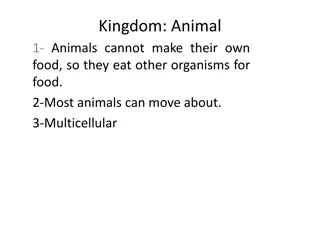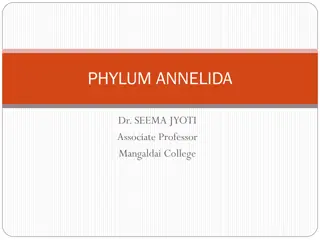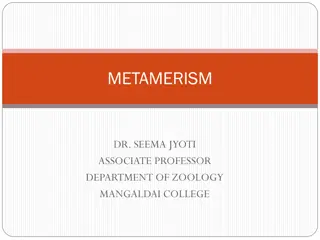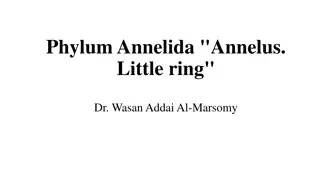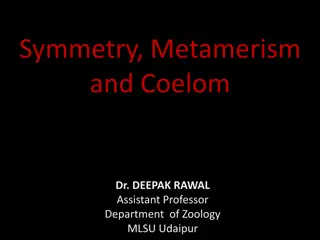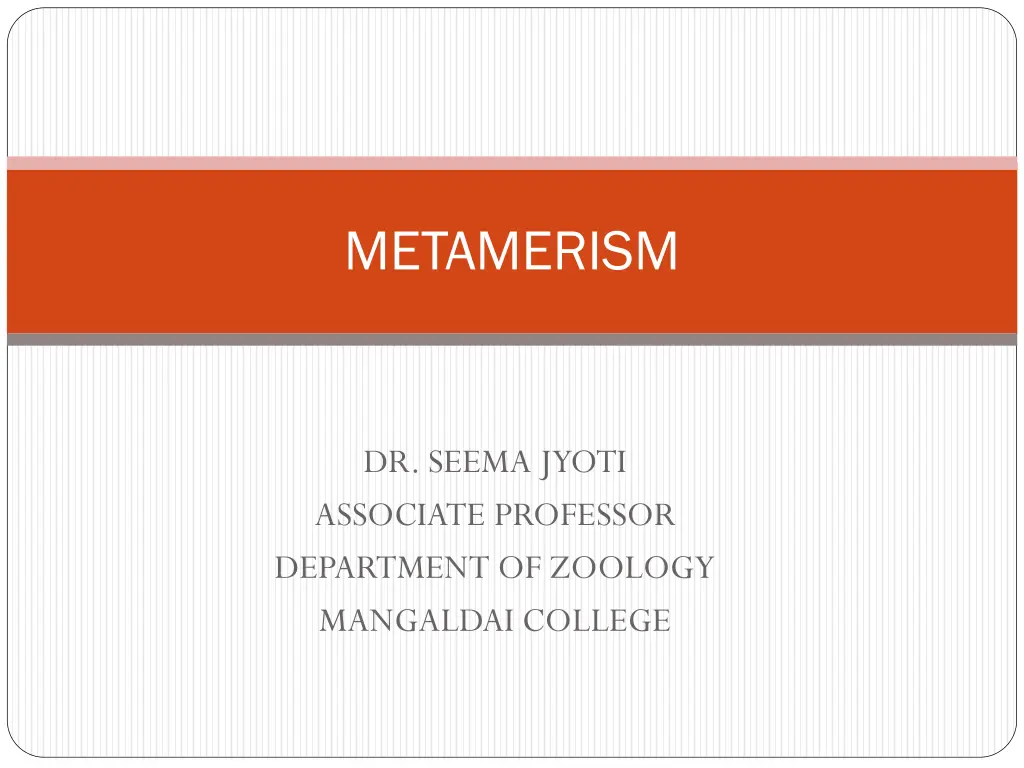
Understanding Metamerism in Bilateral Animals
Metamerism in bilateral animals involves a longitudinal division of the body into similar parts known as somites or segments. This segmentation is visible both internally and externally in organisms like annelids and arthropods. Learn about the definition, evolution, and types of metamerism found in different animal groups.
Download Presentation

Please find below an Image/Link to download the presentation.
The content on the website is provided AS IS for your information and personal use only. It may not be sold, licensed, or shared on other websites without obtaining consent from the author. If you encounter any issues during the download, it is possible that the publisher has removed the file from their server.
You are allowed to download the files provided on this website for personal or commercial use, subject to the condition that they are used lawfully. All files are the property of their respective owners.
The content on the website is provided AS IS for your information and personal use only. It may not be sold, licensed, or shared on other websites without obtaining consent from the author.
E N D
Presentation Transcript
METAMERISM DR. SEEMA JYOTI ASSOCIATE PROFESSOR DEPARTMENT OF ZOOLOGY MANGALDAI COLLEGE
DEFINITION DEFINITION When the segmentation in bilateral animals involves a longitudinal division of the body into a linear series of similar parts, it is termed as metamerism.Ex:Annelida Each part /section is called somite/segment/metamere (Gr., meta, after; meros, part) Each metamere typically repeats some or all of the various organ units.
Metamerism is applied only when organs of mesodermal origin are so arranged. The primary segmental division are the body wall musculature and sometimes the coelom.This in turn imposed a corresponding metamerism systems(nerves,blood vessels and excretory organs). Longitudinal structures gut, principal blood vessels and nerves extend the entire body length, passing through segments. on associated supply
Metamerism limited to the trunk region of the body. The head represented prostomium pygidium which anus metameres.New segments arise just in front of the pygidium. is always by the and carries are not
METAMERIC ANIMALS METAMERIC ANIMALS Annelida Arthropoda Vertebrata Monoplacophora(Mollusca) Metamerism first encountered in Annelida. Metameric segmentation seems to have evolved three times independently in animal kingdom: A) in the Annelis-Arthropods B)in the Chordates C) in Cestodes Fig: Nereis
EXTERNAL AND INTERNAL METAMERISM EXTERNAL AND INTERNAL METAMERISM Metamerism is conspicuously visible in most annelids, both externally and internally. Ex: Earthworm. Earthworm-Its body consists of a great number of similar segments and all the body organs such as musculature, setae of locomotion, blood vessels, nerves, ganglia excretory organs and gonads are repeated segmentally. Even the coelom is divided into segmental compartments by the intersegmental transverse mesenteries called SEPTA. Only digestive tract remains unaffected but it also extends through every segment.
Arthropoda: Metamerism is chiefly external. Man: Internal segmentation of body muscles, nerves,certain blood vessels, vertebrae and ribs.
DIFFERENT TYPES OF METAMERISM DIFFERENT TYPES OF METAMERISM COMPLETE METAMERISM: In annelids, metamerism is complete affecting all the systems. Metameres homonomous, each having segmental blood nerves, nephridia coelomoducts. This is HOMONOMOUS METAMERISM. are alike/ vessels, and called
INCOMPLETE METAMERISM Higher vertebrates, arthropods Segments of different region of their body become greatly dissimilar because of division of labour. This is HETERONOMOUS METAMERISM. In arthropods & vertebrates, metamerism is complete and uniform in embryonic stages becomes obscure in adult due to specialization. This condition always appears first at anterior end and progresses posteriorly. called as larval and but it Fig: A crustacean showing heteronomous segments
Pseudo Pseudo- -metamerism or metamerism or Strobilization Strobilization: : In contrast to true metamerism, pseudo-metamerism or strobilization is seen in tapeworms (Platyhelminthes) where segmentation of the body takes place by the segmentation of the ectoderm. The body consists of a number of segments or proglottids which varies in different individuals of the same species. New segments are added to the body throughout life. The proglottids or segments differ in the degree of development. The segments or proglottids are functionally independent or self-contained units and new segments are always formed and there is no cooperation between the segments. The new segments are formed at the anterior end, just behind the scolex.
Origin and evolution of metamerism Origin and evolution of metamerism Various hypothesis have been proposed to explain the origin of metamerism ,but none is acceptable in absence of convincing evidence. PSEUDOMETAMERISM THEORY: Stresses that metamerism developed secondarily as a result of repetition of body parts, such as muscles, nerves,nephridia, coelom,blood vessels, etc., in a single individual Origin of Metamerism: There are several conflicting views re garding the origin of metamerism 1. Pseudo-metamerism Theory: This theory postulates that the metamerism evolved sec ondarily as a result of repetition of body parts whose ancestor was acoelomate and un- segmented, and contained the various systems or organs which had serially spread out along the entire length of the body (pseudo- segmentation). This is supported by the fact that Turbellarians contained testes, yolk glands, transverse connectives of two nerve cords which are serially repeated along the length of the body, and these organs were separated by the development of septa producing metamerism. The metameric segmentation was linked with the evolution of coelom.
Distinguish between pseudo-metamerism and metamerism: Pseudo-metamerism: 1. Segmentation of the body is related to the segmentation of the ectoderm. 2. New segments are formed at the anterior part of the body (behind the scolex). 3. Segments work as an independent unit. 4. No co-ordination among the segments e.g., tapeworms (Platyhelminthes). Metamerism: 1. Segmentation of the body is related to the segmentation of the mesoderm. 2. New segments are formed at the posterior end of the body (in front of the anal segment). 3. Segments work as different units. 4. Segments work in co-ordination with all other segments e.g., Annelida, Arthropoda, Chordata.
2. Cyclomerism Theory: This theory was proposed by Sedgwick in 1884 and sup ported by Remane in 1950 and 1963. This theory is the corollary of the enterocoelous theory of coelom origin and is associated with the origin of metameric segmentation. It is assumed that the origin of coelom took place from the gastric pouches of some an cestral anthozoan coelenterates. The gastric pouches are separated from the main gastric cavity and arranged in linear fashion. These pouches are transformed into gastric cavity and arranged in linear fashion. These pouches are transformed into coelomic pouches in the protocoelomates. First four gastric pouches are developed in ancestral medusoid coelenterates. Further division of two pouches resulted into three pairs of coelomic cavities, viz., protocoel, mesocoel and metacoel in the protocoelomates. Loss of protocoel (anterior pouch) and mesocoel (lateral two pouches) leads to the formation of un-segmented coelomates, such as mol luscs and sipunculans. Later subdivision of metacoel (posterior pouch) produces seg mented annelids.
3. Corn or Fission Theory: According to this theory, the metameric segmentation resulted due to incomplete separation follow ing the repeated transverse divisions of a non-segmented ancestor or by asexual repro duction producing a chain of sub-individuals or zooids. These zooids are united end to end. Such events occur in scyphozoan strobilae and in platyhelminthes. Remarks: The chief objection of this theory is the sequence of zooid formation in platyhelminthes and scyphozoans is never serial with terminal fission. An other objection is that the reproduction by fission is usually confined to sessile animals where the ancestors were prob ably free-swimming.
4. Locomotion theory: R. B. Clark (1964) proposed the locomotion theory to explain the origin of metamerism. According to this theory, metamerism evolved in annelids as an adaptation to the peristaltic locomotion and for burrowing, and in chordates meta merism is associated with the strong undulatory, serpentine swimming. In annelids, peristaltic locomotion involves shortening and lengthening of body by circular and longitudinal muscles which act against each other. As coelom is filled with coelomic fluid which acts as hydro static skeleton to facilitate the locomotion, but peristaltic movement is not possible until it is compartmented by the development of septa.
With the development of compartmented coelom the fluid pressure main confined to a particular region of the body and it does not affect the whole body. The septa and metameric segmentation to gether allow the part of the body to contract and other parts in the longitudinal axis relax. This enables a strong peristaltic wave to propagate down the body. For burrowing the animals need a hard skeleton but they lack such structure and the coelomic fluid, and inter-segmental septa act as hydraulic skel eton. In chordates the metamerism evolved independently for locomotion. Metamerism allowed the tail muscles to be arranged segmentally for the undulatory movement of the body.
Significance of Metamerism: 1. It helps in locomotion, not only in burrowing but in all other types of locomotion. 2. Metamerism offers division of labour.


